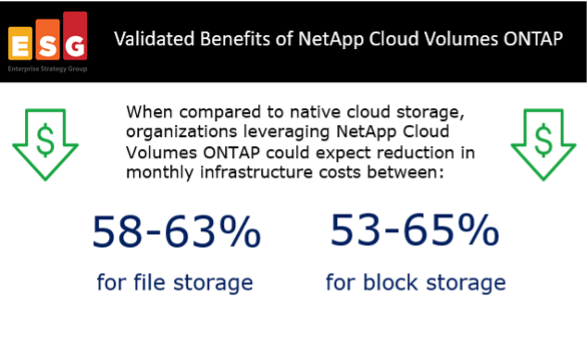
Brought to you by:
Enterprise Strategy Group | Getting to the Bigger Truth™
ESG ECONOMIC VALIDATION
Analyzing the Economic Benefits of NetApp Cloud Volumes ONTAP
By Tony Palmer, Principal Validation Analyst; and Eve Falk, Associate Validation Analyst
APRIL 2022
Executive Summary
While many organizations are turning to hybrid cloud strategies in order to alleviate some business challenges, these organizations are increasingly tasked with managing and securing data across distributed environments, as well as keeping the costs of operations minimized. NetApp Cloud Volumes ONTAP (CVO) was designed to streamline this management and security, while providing financial benefits to its users.
ESG validated the economic benefits that customers have realized since deploying NetApp CVO. Based on several case studies and an analysis of NetApp’s CVO calculators for three public clouds, ESG determined that organizations could save between 58-63% of monthly infrastructure costs for file storage and between 53-65% of monthly infrastructure costs for block storage when compared to the native cloud solution alone.

Introduction
Challenges
Figure 1. Top Five Challenges with Distributed Applications
What are the biggest challenges or concerns your organization has with respect to supporting applications spanning public cloud infrastructure and on-premises data center infrastructure? (Percent of respondents, N=250, three responses accepted)
Source: ESG, a division of TechTarget, Inc.
The Solution: NetApp Cloud Volumes ONTAP
Figure 2. NetApp Cloud Volumes ONTAP
Source: ESG, a division of TechTarget, Inc.
ESG Economic Validation
NetApp Cloud Volumes ONTAP Economic Overview
Cost Savings
“[We] uploaded 19 previously on-premises SQL databases to AWS with Cloud Volumes ONTAP in AWS. The consolidation reduced IT administration responsibility and operational cost."
– Director of Infrastructure Services and Technology Operations, International Airline
Improved Data Availability and Protection
"NetApp Cloud Manager also provides a high-level web interface into NetApp controllers, both on premises and in the cloud, that is very simple, very easy." - CIO and IT Director, US Government Agency
Reduced Complexity
"I have worked in IT for 32 years, and I’ve done lots of storage migrations. This was the easiest storage migration that I’ve had. The transition was very simple, very seamless.”
– CIO and Director of IT , US Government Agency
ESG Analysis
Why This Matters
Block Storage
Figure 3. Azure, AWS, and Google Cloud with CVO Monthly Savings for Databases
Source: ESG, a division of TechTarget, Inc.
File Storage
Figure 4. Azure, AWS, and Google Cloud with CVO Monthly Savings for Unstructured Data
Source: ESG, a division of TechTarget, Inc.
The Bigger Truth
- Reduce monthly infrastructure costs for file storage by 58-63% when compared to native cloud storage alone.
- Reduce monthly infrastructure costs for block storage by 53-65% when compared to native cloud storage alone.
- Improve data availability and protection, leveraging NetApp Snapshot, SnapMirror, and Cloud backup technologies for HA, within and across multiple AZs.
- Simplify cloud storage deployment and management, leveraging NetApp Cloud Manager.
APPENDIX
| Cloud Infrastructure Configuration for Production Workload & Disaster Recovery Scenario | |||
|---|---|---|---|
| Instance Type | Azure VM DS4_V2: 8 vCPUs 28GB Memory |
AWS R5.2xl: 8 vCPUs 64GB Memory |
Google Cloud N1-standard-8 8 vCPUs 30GB Memory |
| Tier to | Azure Blob | S3 | Google Cloud Storage |
| Tier Type | Cool | IA (Infrequent Access) | Coldline |
| Disk Type | Azure Premium Page Blobs | Amazon EBS GP2 | Google Cloud SSD PD |
| Storage Configuration for Production Workload & Disaster Recovery Scenario | |||
| Capacity | 20TB | ||
| CVO Package | Essential | ||
| High Availability | On | ||
| Tiering Percentage | 90% | ||
| Use Volume Clones | 10% | ||
| Number of Retained Daily Snapshots | 30 | ||
| Daily Change Rate of the Primary Data | 3% | ||
| Simulated Scenarios | NFS File System (File Storage) and Database (Block Storage) |
||
| Storage Efficiency | 40% for File Systems 50% for Databases |
||
This ESG Economic Validation was commissioned by NetApp and is distributed under license from TechTarget.
All product names, logos, brands, and trademarks are the property of their respective owners. Information contained in this publication has been obtained by sources TechTarget, Inc. considers to be reliable but is not warranted by TechTarget, Inc. This publication may contain opinions of TechTarget, Inc., which are subject to change. This publication may include forecasts, projections, and other predictive statements that represent TechTarget, Inc.’s assumptions and expectations in light of currently available information. These forecasts are based on industry trends and involve variables and uncertainties. Consequently, TechTarget, Inc. makes no warranty as to the accuracy of specific forecasts, projections or predictive statements contained herein.
This publication is copyrighted by TechTarget, Inc. Any reproduction or redistribution of this publication, in whole or in part, whether in hard-copy format, electronically, or otherwise to persons not authorized to receive it, without the express consent of TechTarget, Inc., is in violation of U.S. copyright law and will be subject to an action for civil damages and, if applicable, criminal prosecution. Should you have any questions, please contact Client Relations at cr@esg-global.com.

Enterprise Strategy Group | Getting to the Bigger Truth™
Enterprise Strategy Group is an IT analyst, research, validation, and strategy firm that provides market intelligence and actionable insight to the global IT community.
